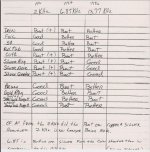I've mentioned in other threads that I'm now hunting deep silver/coins in 5kHz and using multi only to double check suspected bottle caps. Is this a reasonable plan? 5kHz seems to hit harder and deeper than multi BUT you have to double check bottle caps.
Is anyone else primarily using 5kHz?
Thanks!
PS I also disc out 19 and under...and using recover 2 on the 600.
Is anyone else primarily using 5kHz?
Thanks!
PS I also disc out 19 and under...and using recover 2 on the 600.






 It takes me time...thanks!
It takes me time...thanks!

